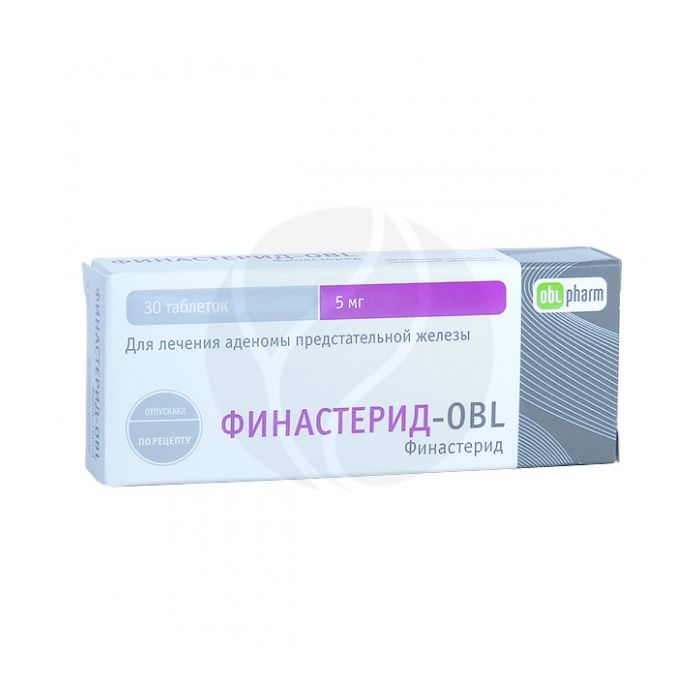Finasteride-OBL tablets 5mg, no. 30
Expiration Date: 05/2027
Russian Pharmacy name:
Финастерид-OBL таблетки 5мг, №30
The daily dose is 5 mg, the frequency of administration is 1 time / day. The treatment is long-term.
Film-coated tablets from light pink to pink, round, biconvex; in cross section, the core is white or almost white.
1 tab. finasteride 5 mg
Excipients: lactose monohydrate, calcium hydrogen phosphate dihydrate, microcrystalline cellulose, croscarmellose sodium, sodium dodecyl sulfate, hyprolose (hydroxypropyl cellulose), magnesium stearate.
Hypersensitivity to finasteride,
obstructive uropathy,
prostate cancer.
Finasteride is not used in women and children.
pharmachologic effect
An inhibitor of 5-alpha reductase, an enzyme that converts testosterone into the more active dihydrotestosterone. Reduces the content of dihydrotestosterone in the blood and prostate tissue. Inhibits the stimulating effect of dihydrotestosterone on the development of prostate adenoma.
Finasteride helps to shrink the enlarged gland, improve urine flow and reduce symptoms associated with benign prostatic hypertrophy. It may take several months of treatment to reduce the clinical manifestations of the disease.
Pharmacokinetics
It is well absorbed and penetrates into tissues and body fluids, it is found in the ejaculate. Bioavailability is 80% and does not depend on food intake. Cmax is achieved in 1-2 hours. The connection with plasma proteins is 90%. It is excreted in the form of metabolites by the kidneys (39%) and through the intestines (57%). T1 / 2 - 6-8 hours. Long-term (3-7 months) intake at a dose of 5 mg / day reduces the concentration of 5-alpha-dihydrotestosterone in the blood serum by 70%.
Side effect
From the reproductive system: rarely - impotence, decreased libido, decreased ejaculate volume, gynecomastia.
Allergic reactions: possible skin rash, angioedema.
Application during pregnancy and lactation
Women of childbearing age and pregnant women should avoid contact with the drug, because it has teratogenic properties (the ability to suppress the conversion of testosterone into dihydrotestosterone can cause impaired development of the genital organs in a male fetus), penetrates into the seminal fluid.
Application for violations of liver function
Finasteride is used with caution in liver failure.
Application in children
The drug is not used in children.
special instructions
Finasteride is used with caution in liver failure.
With a large volume of residual urine and / or a sharply reduced urine flow, it is necessary to keep in mind the development of obstructive uropathy.
Before starting treatment with finasteride and periodically during treatment, a rectal examination should be performed, as well as a study by other methods for the presence of prostate cancer.
Drug interactions
There was no clinically significant interaction of finasteride with propranolol, digoxin, glyburide, warfarin, theophylline and antipyrine.
Apparently, finasteride does not significantly affect the enzyme system of cytochrome P450 and, accordingly, does not affect the pharmacokinetic parameters of drugs metabolized by liver microsomal enzymes.
With the simultaneous use of finasteride with ACE inhibitors, alpha-blockers, beta-blockers, calcium channel blockers, nitrates, diuretics, blockers of histamine H2-receptors, inhibitors of HMG-CoA reductase, NSAIDs, quinolones and benzodiazepines, no drug interactions were noted.

